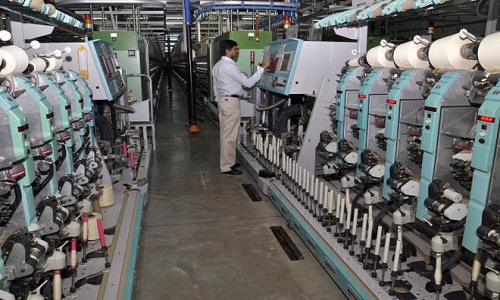"Bangladesh has been setting examples with factory automation in textile and factories. The classic case is of Mohammadi Fashion Sweaters factory in Dhaka where a few dozen workers supervise 173 German-made machines which knit black sweaters for overseas buyers. Surely, this is a huge transformation compared to a few years ago, when hundreds of employees could be found standing over manual knitting stations for up to 10 hours a day. Mohammadi’s owners began phasing out such work in 2012, and by last year, the knitting process was fully automated."

Bangladesh has been setting examples with factory automation in textile and factories. The classic case is of Mohammadi Fashion Sweaters factory in Dhaka where a few dozen workers supervise 173 German-made machines which knit black sweaters for overseas buyers. Surely, this is a huge transformation compared to a few years ago, when hundreds of employees could be found standing over manual knitting stations for up to 10 hours a day. Mohammadi’s owners began phasing out such work in 2012, and by last year, the knitting process was fully automated. Rubana Huq, MD, Mohammadi Group, says it doesn’t make sense to slowdown and not automate. The company makes sweaters for H&M, Zara and other Western brands. The factories replaced about 500 workers with machines and may buy more.

A 2016 International Labor Organization study predicted that some Asian nations could lose more than 80 per cent of their garment, textile and apparel manufacturing jobs as automation spreads. While plenty of labour is available in countries like Bangladesh, Cambodia and China, increasing labour costs have been pushing companies to move towards automation. At the same time, technology is becoming so advanced that machines can increasingly handle difficult tasks such as manipulating pliable fabrics, stitching pockets and attaching belt loops to pants.
Erik Brynjolfsson, Director, MIT Initiative on Digital Economy, feels developing countries are in the bull’s eye of this automation revolution as robots master repetitive tasks once dominated by poor nations. Most jobs of the future require significant skills training—and that is where more-developed nations thrive.
Analysts estimate Bangladesh needs roughly two million new jobs a year to keep pace with its expanding labour force, with garments offering many of the best opportunities. Yet the number of new jobs added by the garment and textile trades has fallen to 60,000 a year, from over 300,000 annually between 2003 and 2010, according to World Bank data. Bangladesh’s apparel production has been fueling growth with help of automation. From 2013 to mid-2016, annual Bangladeshi garment exports increased by 19.5 per cent and the garment sector jobs increased by 4.5 per cent over the same period. On the demand-supply imbalance, Zahid Hussain, the World Bank’s lead Bangladesh economist, stated that if companies cannot absorb young people in productive activities, they will do something. And the something they will do may not be socially pleasant. It’s a social time bomb.
Advantages of technology
Automation has many advantages, especially in richer countries. By boosting efficiency, new technologies help keep consumer prices for jeans and other fast fashion products low. Automation could also help bring some apparel production back to places with more-expensive labour, including the US. In Bangladesh, Nazma Akter, a union leader, says savings from automation has emboldened factory owners to resist worker demands. In a recent labour dispute, factory owners threw up their hands and said if workers wouldn’t agree to management’s plans, they would simply automate jobs. Factories that earlier had 300 workers now have 100 workers only, says Akter, President, Sommilito Garments Sramik Federation. In such a situation, some of the biggest clothing producers feel they have little choice but to automate as cost pressures intensify.
Consumers, accustomed to a widening array of inexpensive fashions, have resisted price increases that could help pay for them. The emergence of new competitors, including East African nations, has added further pressure. Mostafiz Uddin, Chief Executive, Denim Expert, sums up well, if companies don’t change themselves, they will lose out on the entire business.












